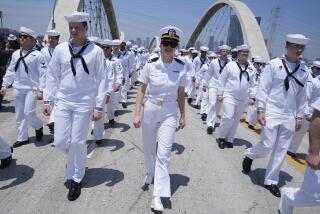Kitty Hawk Savors Homecoming
- Share via
YOKOSUKA, Japan — For Kelly Cook, the hardest part was the last few weeks, when she knew the long voyage was almost over. For Lance Lindley, it was the relative monotony of working in a metal-walled office without a day off. For Damon Ray, it was going without the spicy food he loves.
“I’ve been dying to eat some really hot chili,” said Ray, a petty officer from Albuquerque in his fifth year with the Navy. “For a Mexican Indian from the Southwest, there just isn’t the same edge” with Navy food.
The emotional return this week of the Kitty Hawk aircraft carrier to its home port of Yokosuka just in time for Christmas was a joyous event for its crew after 73 straight days at sea, during which it launched warplanes and helicopters on missions in and around Afghanistan.
In the old days, large naval vessels routinely spent months at sea without a port call. But in today’s all-volunteer service, where lifestyle is an important selling point for recruiters trying to compete with private-sector employers, 10 to 14 days away from terra firma is the norm.
With the holiday season upon them, crew members said their thoughts these days are focused even more than usual on their hometowns--and not merely out of a natural desire to spend time with their families. Several said they wanted to experience firsthand the newfound patriotism and respect for the military in America since the Sept. 11 terrorist attacks.
“It’s not that there were negative feelings, but people just weren’t that aware of the military,” Cardinal Roger M. Mahony, archbishop of Los Angeles, said on a visit to Japan to meet with troops and conduct services during Christmas week. “After Vietnam, the whole military went subsurface. Now that’s all changed.”
Service members say they run into a lot fewer people these days questioning the size of the U.S. military budget.
“I feel the country is really backing us now,” Ray said. “You feel like you’re here for a purpose. It makes the job much more rewarding.”
Mahony, who oversees the largest Roman Catholic archdiocese in the United States, said one of the messages he has given repeatedly during his visit this week is: You’re appreciated.
Sailors aboard the Kitty Hawk said the 10 weeks at sea without a shore break was largely marked by the routines and minor frustrations of doing a job without time off.
To break the monotony, the giant ship stopped one day in the middle of the ocean and the flight deck was turned into a giant picnic area as the crew grilled hamburgers and hot dogs. A few sailors stood guard against sharks, with rifles at the ready, as sailors jumped off a lower deck into deep-blue water.
Despite the size and population of the ship--its 5,000-plus occupants make it a small floating city--crew members said they often go for days without venturing much beyond the confines of office, mess hall and sleeping quarters.
“You tend to live in your little neighborhood aboard ship,” Chief Journalist Lindley said.
One of the biggest inconveniences of going to war, sailors said, was that e-mail was cut off for several days for security reasons to prevent anyone from disclosing the ship’s location.
“I almost died,” said Cook, an aviation maintenance administrator and one of 250 women aboard. “You don’t realize how dependent you are on e-mail. That’s how I communicate with everyone in my family.”
Eventually, the Navy devised a system called “Freedom E-mail” whereby an intermediary read all outgoing messages before shipping them out under a single address. It initially limited usage to once a week, but pent-up demand and the important link the service helped maintain with families back home eventually pushed this up to once a day.
The Kitty Hawk, commissioned in 1961, has seen action in Vietnam, the Somalia campaign and enforcement of the southern “no-fly” zone in Iraq.
More to Read
Sign up for Essential California
The most important California stories and recommendations in your inbox every morning.
You may occasionally receive promotional content from the Los Angeles Times.













